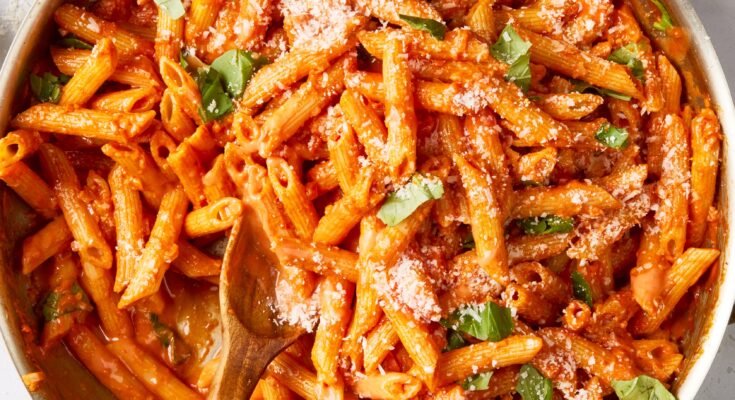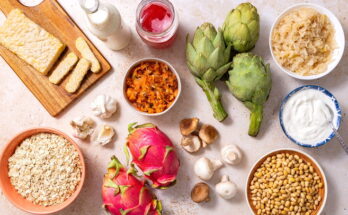Vodka Sauce Recipe: Vodka sauce is a delicious, creamy pasta sauce known for its vibrant pink hue and rich, tangy flavor with a hint of spice.
This sauce, made with a blend of tomato, cream, and vodka, is the perfect companion to pasta, blending Italian and American influences into one mouthwatering dish.
Today, we’ll guide you through each step to help you create a smooth, restaurant-quality vodka sauce at home.
What Makes Vodka Sauce Unique?
The secret to vodka sauce’s flavor lies in the way the vodka helps to release flavors from the tomatoes, creating a deeper, more balanced taste that’s unique from traditional tomato sauces. Vodka in the sauce doesn’t make it alcoholic, but it amplifies the sauce’s aromatic qualities and highlights the creaminess, giving the sauce a wonderfully velvety texture.
Ingredients Required
Before we start, here’s a rundown of the main ingredients you’ll need for a classic vodka sauce:
- Olive oil (2 tablespoons)
- Butter (1 tablespoon)
- Garlic cloves (3-4, minced)
- Onion (1 small, finely chopped)
- Tomato paste (1/2 cup)
- Vodka (1/4 cup)
- Heavy cream (3/4 cup)
- Parmesan cheese (1/2 cup, grated)
- Salt and pepper (to taste)
- Fresh basil or parsley (optional, for garnish)
Optional additions include a pinch of red pepper flakes for a bit of heat and Italian herbs like basil or oregano for added depth.
Step-by-Step Guide to Making Vodka Sauce
Step 1: Preparing Your Ingredients
Start by organizing your ingredients. Chop the onion finely, mince the garlic, and measure out your tomato paste, vodka, cream, and cheese. Having everything ready ensures that each ingredient goes into the pan at the perfect time, especially since vodka sauce comes together relatively quickly.
Step 2: Sautéing the Garlic and Onion
Heat a large skillet over medium heat and add the olive oil and butter. Once the butter melts, add the chopped onions, stirring occasionally until they become translucent (about 3-4 minutes). Add in the garlic and sauté for another minute.
Tip: Stir the garlic constantly to avoid burning it, as it can quickly become bitter. The onions should soften but not brown, creating a subtle, savory base for the sauce.
Step 3: Adding Tomato Paste for Depth
Once the onions and garlic are ready, add the tomato paste directly into the skillet. Stir it with the onions and garlic, allowing it to cook for about 2-3 minutes. This step brings out the tomato paste’s sweetness and enhances its deep red color, giving your sauce a richer, more robust flavor.
Why Tomato Paste? Tomato paste is thick and concentrated, lending body and a bold tomato taste that’s essential to vodka sauce.
Step 4: Deglazing with Vodka
After the tomato paste has caramelized slightly, it’s time to add the vodka. Carefully pour the vodka into the skillet, stirring immediately to combine it with the tomato paste. Let it simmer for 3-4 minutes, allowing the alcohol to cook off.
Safety Tip: Use caution when adding vodka to a hot pan, and never pour directly from the bottle. If you’re sensitive to alcohol, don’t worry—the alcohol evaporates, leaving only the flavor behind.
Step 5: Adding the Cream
Now it’s time to transform the sauce with cream. Pour in the heavy cream slowly, stirring constantly to achieve a smooth, pink-colored sauce. The cream should be fully incorporated, and the sauce will take on that signature “blush” color. Let it simmer for another 5 minutes until the sauce thickens slightly.
Tip: If you prefer a slightly thicker sauce, you can let it simmer a bit longer. But be careful not to overheat the cream to prevent it from curdling.
Step 6: Simmering the Sauce to Perfection
Lower the heat to a gentle simmer and let the sauce cook for another 5-10 minutes. This step allows all the flavors to meld together, resulting in a well-balanced, creamy vodka sauce with a mild tang. Stir occasionally to ensure that the sauce doesn’t stick to the bottom.
Enhancing the Flavor
Adding Herbs and Spices
For an extra layer of flavor, sprinkle in some salt and pepper, and, if you like, add a pinch of red pepper flakes or Italian seasoning. This adds a subtle heat that complements the creaminess of the sauce. Fresh basil or parsley makes a great garnish, adding a hint of freshness.
Using Parmesan or Pecorino Cheese
Stir in the Parmesan or Pecorino cheese, which will melt into the sauce, creating a richer, savory taste. For the best results, use freshly grated cheese, as pre-packaged varieties might not melt as smoothly.
Tip: If you like a cheesier flavor, add a bit more cheese to taste.
Serving Suggestions for Vodka Sauce
Best Pasta Pairings for Vodka Sauce
Vodka sauce pairs beautifully with many types of pasta, but traditionally, it’s served with penne or rigatoni, as the ridges help hold the sauce. To cook the pasta perfectly, bring a large pot of salted water to a boil, add the pasta, and cook until al dente according to package instructions.
Alternative Uses for Vodka Sauce
Besides pasta, vodka sauce is a versatile addition to other dishes. Use it as a pizza sauce base, a topping for grilled chicken or shrimp, or as a delicious dip with crusty bread. This sauce can even be incorporated into casseroles for added creaminess.
Storage and Reheating Tips
How to Store Vodka Sauce
If you have leftovers, let the sauce cool completely before transferring it to an airtight container. It can be stored in the refrigerator for up to 5 days or in the freezer for up to 3 months. For freezing, use a freezer-safe container and leave a little room for expansion.
Reheating Vodka Sauce Properly
To reheat, warm the sauce over low heat in a skillet, stirring occasionally to prevent separation. If it seems too thick, add a splash of milk or cream to restore its creamy texture.
FAQs about Vodka Sauce Recipe
What is vodka sauce?
Vodka sauce is a creamy tomato-based sauce with a hint of vodka, typically served over pasta. It combines tomatoes, cream, and a splash of vodka, which enhances the flavors without a strong alcohol taste.
Why add vodka to the sauce?
The vodka helps release flavors from the tomatoes and enhances the creaminess of the sauce. During cooking, the alcohol mostly evaporates, leaving a subtle flavor that brings out the richness of the sauce.
Is vodka sauce suitable for kids?
Yes, as the alcohol mostly cooks off, vodka sauce is generally safe for children. However, you can substitute the vodka with a bit of water or lemon juice if you’d prefer to avoid alcohol completely.
What pasta pairs best with vodka sauce?
Penne and rigatoni are popular choices because they hold the sauce well. However, vodka sauce can be served with any pasta you prefer.
Can I make vodka sauce dairy-free?
Yes! You can substitute the heavy cream with coconut milk or a dairy-free alternative for a similar creamy texture.
Conclusion
Making vodka sauce from scratch is simple and rewarding. With just a few ingredients and a bit of patience, you can enjoy a sauce that’s full of flavor, rich, and creamy. Experiment with different seasonings or cheeses to personalize your vodka sauce, and try it with various pasta types or other dishes to make it a versatile favorite in your kitchen.



